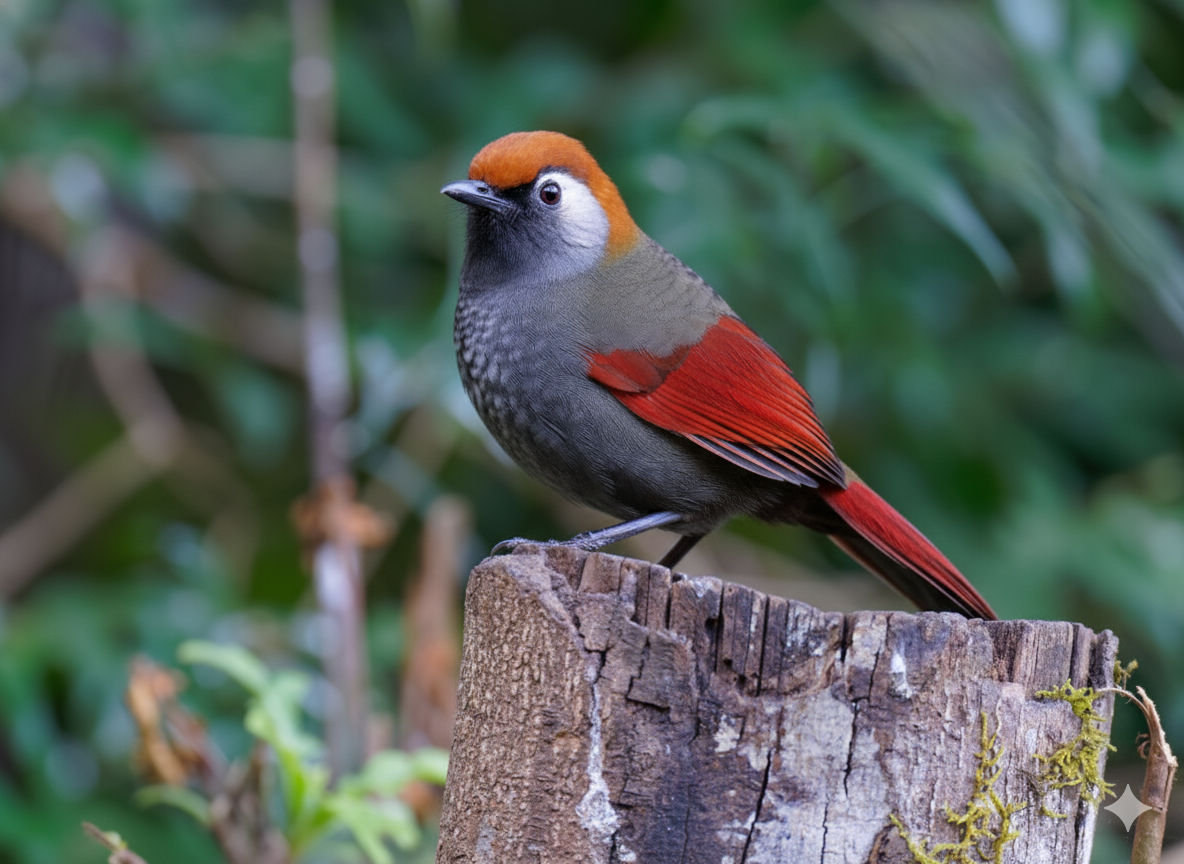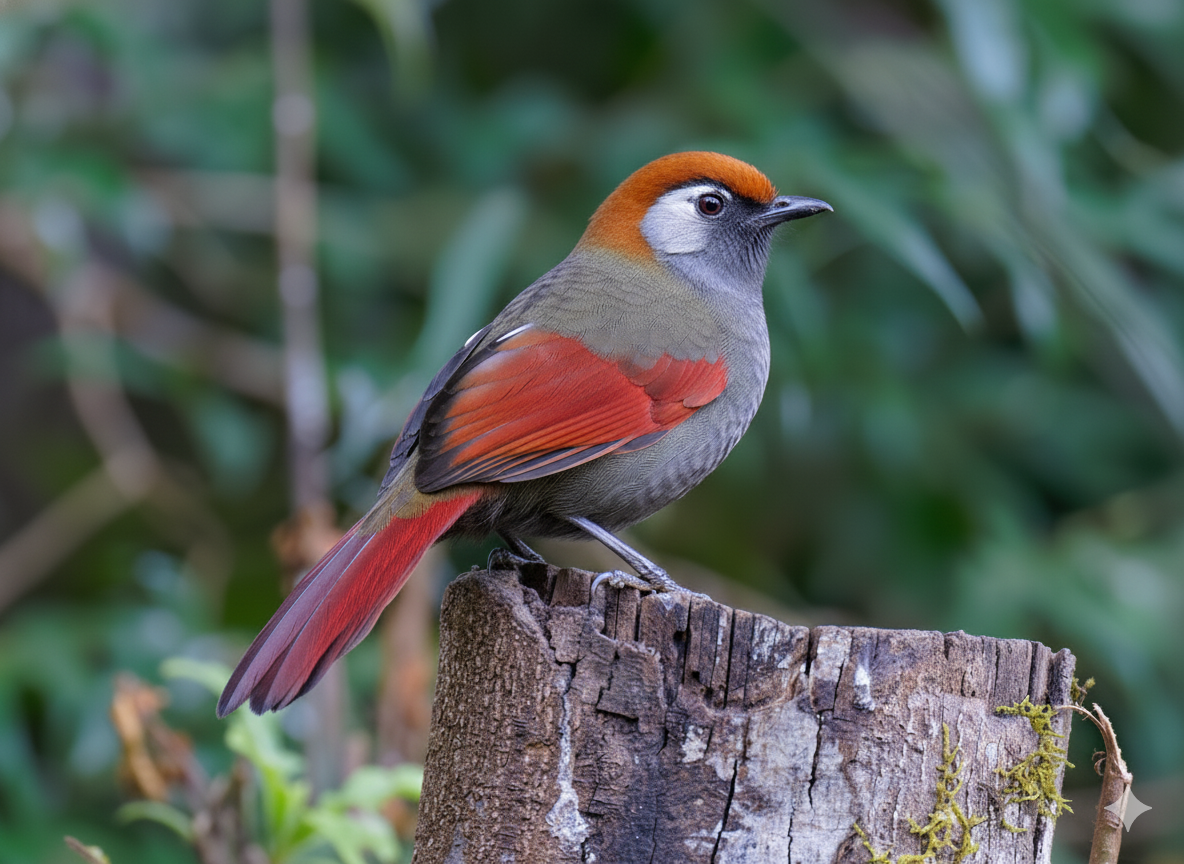Deep in the misty, high-elevation forests of the Himalayas and Southeast Asia, a flash of crimson red cuts through the green. It’s followed by a sound that gives the bird its name: a bubbling, “laughing” call that seems to echo through the trees.
This is the Red-tailed Laughingthrush (Trochalopteron milnei), a bird that combines stunning beauty with a charismatic, social personality. For birdwatchers and nature lovers, a glimpse of this striking creature is a true highlight of the Asian montane forest.
While not as iridescent as a hummingbird or as grand as a peacock, its beauty is one of elegant, dramatic contrast. Here’s why this forest-dweller is one of Asia’s most beautiful and captivating birds.
A Flash of Crimson in the Clouds
The Red-tailed Laughingthrush is a masterclass in ornithological art. It doesn’t rely on flashy iridescence. Instead, its beauty comes from a bold, sophisticated color palette.
- The Body: The bird’s body is a soft, understated slate-gray or dull, earthy brown. This serves as the perfect canvas for its more dramatic features.
- The Head: A rich, rufous-chestnut crown sits like a cap, which contrasts sharply with a jet-black “mask” on its face. This mask is often highlighted by silvery-white ear-coverts, giving it a very defined and expressive look.
- The “Wow” Factor: The features that give the bird its name are its wings and tail. Both are a stunning, deep crimson or bright, fiery red. When the bird is perched, this red peeks out as a slash of color. But in flight, it fans out, creating a spectacular flash of red against the backdrop of the dark, green forest.
Unlike many bird species, the male and female Red-tailed Laughingthrush look nearly identical, sharing this beautiful plumage.

The “Laughing” Bird of the Mountains
What makes a “laughingthrush” laugh? The name comes from its incredible vocalizations. This bird is part of a family known for its loud, bubbling, and often human-like “laughing” calls.
They are highly social and vocal birds, often traveling in small, energetic flocks that communicate constantly. Their call is one of the most distinctive sounds of their high-altitude home, a cheerful, melodious, and sometimes mimic-filled song that rings through the undergrowth.
A Secretive Life in the Forest
The Red-tailed Laughingthrush is not a bird you’ll find in your backyard garden. It is a specialist of a very specific and magical habitat.
- Habitat: It lives in the understory of dense, subtropical, and tropical moist montane forests. Think of high-elevation (4,000 – 8,200 ft) broadleaf evergreen forests, often shrouded in mist.
- Range: This bird is found in a swath of Asia, from the eastern Himalayas through northeastern India, Myanmar, Thailand, Laos, Vietnam, and southern China.
They spend most of their lives in the dense, low-level vegetation, foraging on the forest floor or in low bushes. They are omnivores, using their strong bills to hunt for insects, beetles, and snails, as well as to eat fruits, berries, and seeds.
Quick Facts: The Red-tailed Laughingthrush
- Scientific Name: Trochalopteron milnei
- Habitat: High-elevation (montane) broadleaf forests
- Diet: Omnivorous (insects, fruit, seeds)
- Social: Lives in small, vocal, social flocks.
- Nesting: Both parents build a cup-shaped nest of grass and bamboo leaves low to the ground.
- Conservation Status: Least Concern (IUCN 3.1)
A Beautiful, Hidden Gem
The Red-tailed Laughingthrush is a perfect symbol of the rich, hidden biodiversity of Asia’s mountain forests. It’s a bird that is more often heard than seen, but when it does make an appearance, it is an unforgettable sight.
Its combination of a shy, secretive nature with such loud, joyful calls and stunning, fiery plumage makes it one of the most sought-after and beautiful birds in its entire range.
Have you ever been lucky enough to see a laughingthrush in the wild? Share your experience in the comments below!



